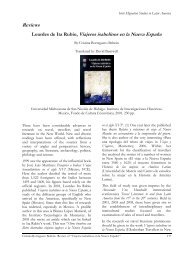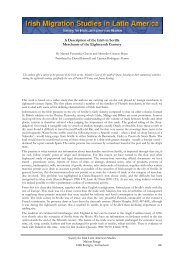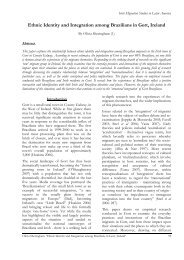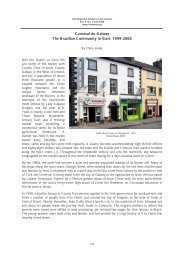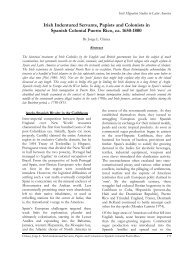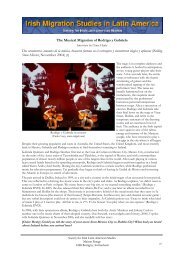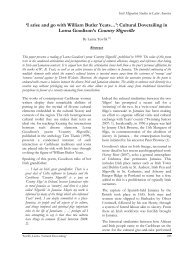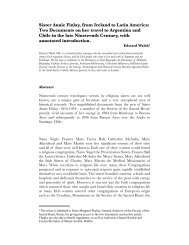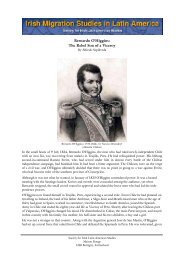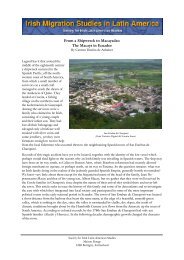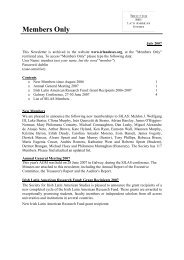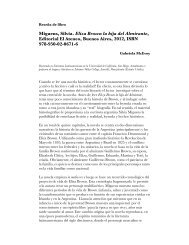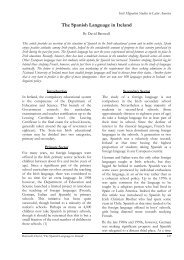I:6 Anti-dumping - Society for Irish Latin American Studies
I:6 Anti-dumping - Society for Irish Latin American Studies
I:6 Anti-dumping - Society for Irish Latin American Studies
You also want an ePaper? Increase the reach of your titles
YUMPU automatically turns print PDFs into web optimized ePapers that Google loves.
An article, which appeared in The Standard in 1925, stated that:<br />
“Wherever the <strong>Irish</strong> settled, their priests went with them to direct their progress and share their trials. In Argentina,<br />
the priests made sure that the first <strong>Irish</strong> immigrants who had become wealthy farmers donated land to build<br />
chapels which became not only places of worship but also schools and social centres <strong>for</strong> the whole community.” [75]<br />
A quick look at the schools described previously should suffice to demonstrate that the majority of the<br />
<strong>Irish</strong>-Argentine schools were linked to religious orders. The example of Father Fahy, the visionary Dominican<br />
who founded the first <strong>Irish</strong>-Argentine school, was followed by the priests he had <strong>for</strong>med and<br />
brought from Ireland, such as Patrick Joseph Dillon and Michael Leahy.<br />
The Sisters of Mercy occupy the first place in the “Honour roll”: besides establishing numerous schools<br />
(Mater Misericordiae, Saint Ethnea’s, Saint Mary’s, Clonmacnoise, Saint Anne’s, etc.), they also administered<br />
others, such as Saint Bridget’s. The Passionist Fathers founded Saint Paul’s in Carmen de Areco, while the<br />
Pallotines created Saint Patrick’s in Mercedes. The Passionist Sisters established Michael Ham Memorial<br />
College and the Christian Brothers, Cardinal Newman. And let’s not <strong>for</strong>get the religious orders connected<br />
with the schools of the Ladies of Saint Joseph’s <strong>Society</strong>!<br />
In the period we are studying, very few schools were private enterprises. The first schools established by<br />
private individuals had a short life. Lawrence Dillon and Sean Healy were more successful. Beyond the<br />
religious or non-religious origin, the great majority of these establishments have religious names, resorting<br />
often to saints.<br />
If we study the programmes, we confirm that religion is part of the curriculum of every single <strong>Irish</strong>-<br />
Argentine school, both be<strong>for</strong>e and after the secularisation of education (through the Ley 1420 of 1884).<br />
We have mentioned the religious practices of the girls’ schools which included masses, rosaries and<br />
peregrinations. Sacred history is also mentioned in the advertisements of different schools.<br />
The Southern Cross also admonished the parents about the necessity of educating children in the faith of<br />
their elders. The newspaper joined other media in deploring the sanction of the Ley 1420, receiving it as<br />
the triumph of “godless education”. [76]<br />
In a pastoral letter addressed to the <strong>Irish</strong>-Argentines, Monsignor Espinosa warns that:<br />
“The great evil of these times is the religious indifference with which our environment is saturated, and even the<br />
most pious families suffer the consequences of this evil, if parents don’t show the necessary concern <strong>for</strong> the <strong>for</strong>mation<br />
of their children’s heart. Do not entrust them to the cares of non Catholic teachers, since the impression caused on<br />
your children when they see that people they respect do not profess the faith of their parents, is usually undeletable.<br />
When choosing a school always favour catholic schools, that devote themselves especially to the religious instruction of<br />
their pupils.” [77]<br />
“Every Catholic child in a Catholic school” was the slogan that the author of the section “The Catholic<br />
World” proposed to adopt in his article of March 19, 1926. He compared the “disloyal and disobedient”<br />
Catholics who sent their children to secular schools” to those “good” Catholics who “gladly made sacrifices<br />
to safeguard their children against the perils to faith and morals, so common in a society which is fast<br />
persuading itself that it can get along better without God than with God.” [78]<br />
The rejection of secular education is present in a 1933 article that urges to follow the example of Brazil -<br />
where religious education had been reinstated- and which states:<br />
“Till the clear idea of God and the duties of men towards Him pervades in our national life, we shall not<br />
have real civilization. Our educational system is growing powerless be<strong>for</strong>e the evils of the times. Our youth<br />
are growing up into a race of criminals. Our schools are seriously endangered by Communism and sane<br />
and sound patriotism is on the wane. The only real remedy is implantation of religion in our schools.”<br />
[79]<br />
Closely connected to the religious <strong>for</strong>mation is moral education, which stems out from the <strong>for</strong>mer. Sean<br />
Healy expressed his point of view:<br />
“[…] education is a far greater matter than the mere acquisition of proficiency in scholastic subjects. The<br />
good teacher is constantly preoccupied with the <strong>for</strong>mation and development of character, the inculcation<br />
of moral values such as self-discipline, the virtues of truth, courage, loyalty and honesty, which <strong>for</strong>m the<br />
María José Roger, The Children of the Diaspora .................................................................................. 17



